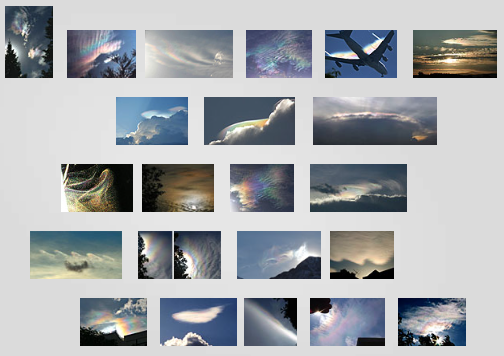Iridescent Clouds
Iridescent Clouds: A Spectacular Display of Color in the Sky
Have you ever looked up at the sky and noticed vibrant, shimmering colors within the clouds? These mesmerizing displays are known as iridescent clouds. While they may not be as common as other atmospheric phenomena, such as rainbows or halos, iridescent clouds are truly a sight to behold. In this article, we will delve into the science behind iridescence, explore the different types of iridescent clouds, and uncover the conditions necessary for their formation.
Understanding Iridescence
Iridescence is a phenomenon that occurs when light is diffracted, or bent, as it passes through tiny water droplets or ice crystals in the atmosphere. This bending of light causes the different wavelengths to separate, resulting in the stunning array of colors seen in iridescent clouds. Similar to how a prism breaks white light into its constituent colors, iridescence creates a beautiful display of hues that seem to dance across the sky.
Types of Iridescent Clouds
Iridescent clouds can take on various forms, each with its own unique characteristics. Here are some of the most common types:
-
Cirrus Iridescence: Cirrus clouds, which are thin and wispy, often exhibit iridescence due to their high altitude and composition of ice crystals. These clouds can appear as delicate bands or patches of vibrant colors against a backdrop of blue sky.
-
Altocumulus Iridescence: Altocumulus clouds, characterized by their puffy and rounded shape, can also display iridescence. The presence of water droplets or ice crystals within these mid-level clouds creates the perfect conditions for the phenomenon to occur.
-
Stratocumulus Iridescence: Stratocumulus clouds, which form in a layer-like structure, occasionally exhibit iridescence as well. These low-level clouds can showcase subtle pastel shades when the sunlight interacts with their droplets or crystals.
Factors Affecting Iridescent Cloud Formation
While the presence of water droplets or ice crystals is essential for iridescent clouds to form, several other factors influence the intensity and visibility of these colorful displays. Some of these factors include:
-
Cloud Thickness: Thicker clouds tend to produce more pronounced iridescence due to the increased number of water droplets or ice crystals present.
-
Sun Angle: The angle at which sunlight interacts with the clouds plays a crucial role in the visibility of iridescence. When the sun is lower on the horizon, such as during sunrise or sunset, the light has a longer path to travel through the atmosphere, enhancing the chances of observing iridescent clouds.
-
Cloud Opacity: The transparency of the cloud layer can impact the intensity of iridescence. More transparent clouds allow for greater light transmission and, consequently, more vibrant colors.
-
Cloud Movement: The motion of the clouds can also affect iridescence. When the cloud layer is relatively stable, the colors may appear more stationary. However, if there is turbulence or vertical motion within the clouds, the colors can seem to shift and change rapidly.
Capturing the Beauty of Iridescent Clouds
If you're fortunate enough to witness iridescent clouds, you may want to capture their beauty through photography. Here are a few tips to help you document this ethereal phenomenon:
- Use a polarizing filter to reduce glare and enhance color saturation.
- Experiment with different camera settings, such as exposure and white balance, to achieve the desired effect.
- Consider including other elements in your composition, such as trees or buildings, to provide context and scale.
Appreciating Nature's Artistry
In conclusion, iridescent clouds offer a remarkable display of nature's artistry in the sky. Their shimmering colors and ethereal beauty make them a captivating sight for those lucky enough to witness them. Whether you're an avid sky watcher or simply enjoy the wonders of the natural world, keep an eye out for these breathtaking displays and let yourself be awed by the magic of iridescence.

</blog/iridescent-clouds-5/>
</blog/iridescent-clouds-banded-iridescence/>
</blog/wave-cloud-iridescence/>
</blog/iridescent-clouds-7/>
</blog/iridescent-aircraft-condensation-cloud/>
</blog/iridescence-county-wicklow-ireland/>
</blog/pileus-cloud-iridescence-singapore/>
</blog/iridescence-in-pileus-cloud/>
</blog/iridescence-in-pileus-cloud-iii/>
</blog/iridescence-above-sun-warmed-damp-wood/>
</blog/low-sun-iridescence-california/>
</blog/iridescent-clouds-4/>
</blog/iridescence-orlando-florida/>
</blog/iridescent-wave-structure/>
</blog/iridescent-clouds-and-the-corona/>
</blog/iridescent-clouds-and-the-corona/>
</blog/eiger-iridescence/>
</blog/iridescence/>
</blog/iridescent-clouds-near-paris/>
</blog/iridescent-clouds-3/>
</blog/lenticular-cloud-iridescence/>
</blog/iridescent-clouds-8/>
</blog/iridescent-clouds-6/>
Note: this article has been automatically converted from the old site and may not appear as intended. You can find the original article here.
Reference Atmospheric Optics
If you use any of the definitions, information, or data presented on Atmospheric Optics, please copy the link or reference below to properly credit us as the reference source. Thank you!
-
<a href="https://atoptics.co.uk/blog/iridescent-clouds-2/">Iridescent Clouds</a>
-
"Iridescent Clouds". Atmospheric Optics. Accessed on October 21, 2024. https://atoptics.co.uk/blog/iridescent-clouds-2/.
-
"Iridescent Clouds". Atmospheric Optics, https://atoptics.co.uk/blog/iridescent-clouds-2/. Accessed 21 October, 2024
-
Iridescent Clouds. Atmospheric Optics. Retrieved from https://atoptics.co.uk/blog/iridescent-clouds-2/.